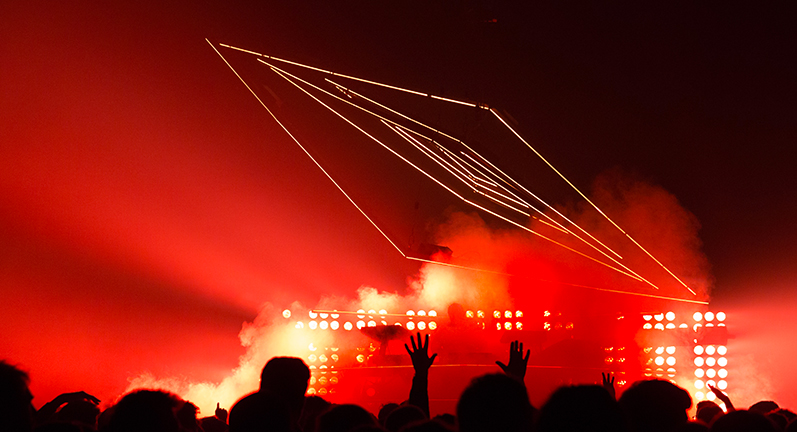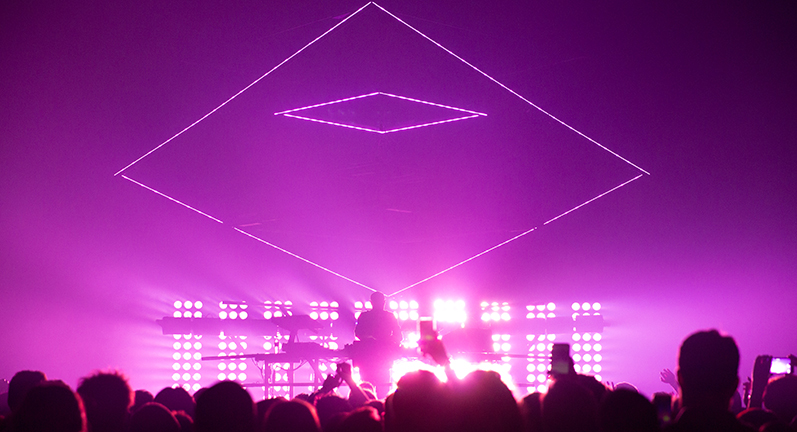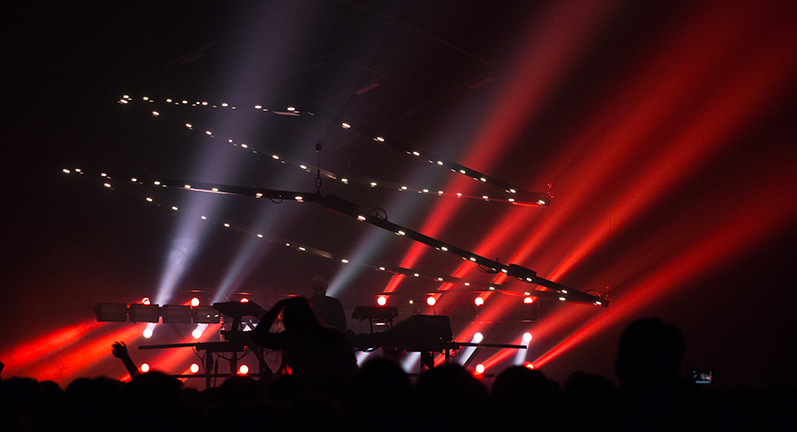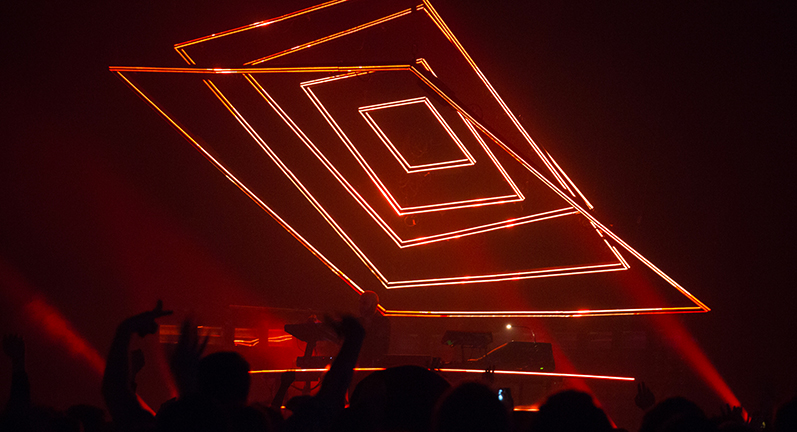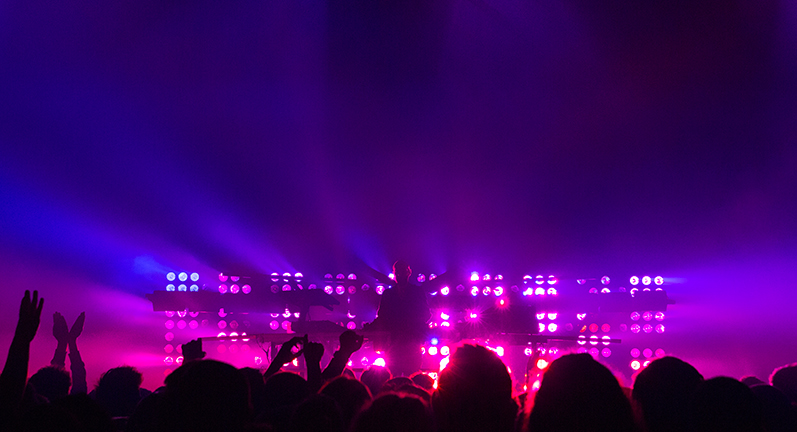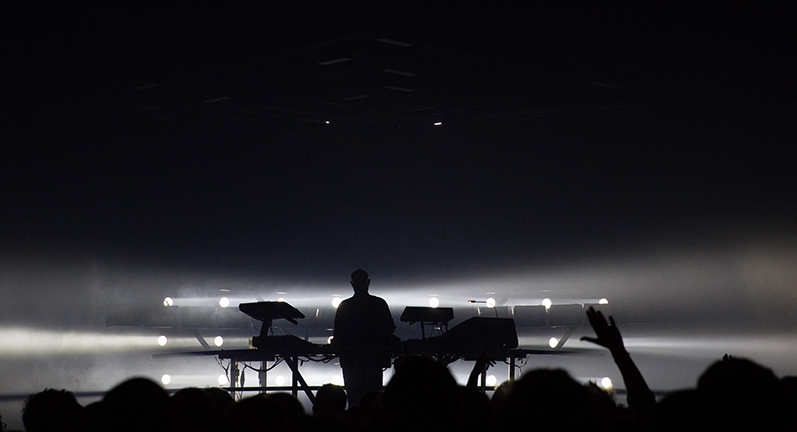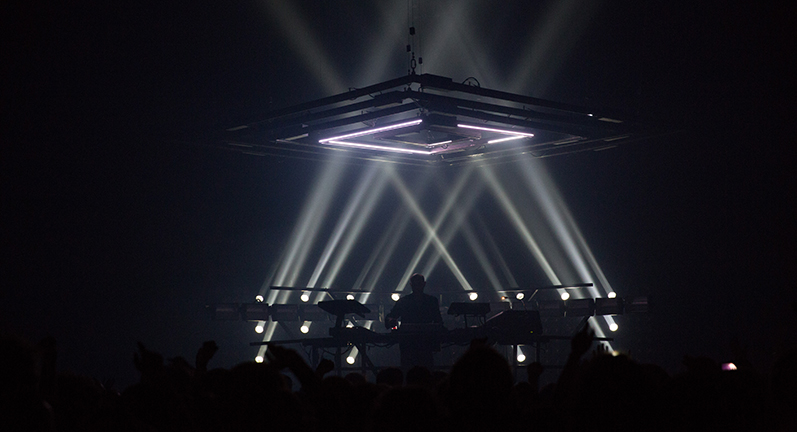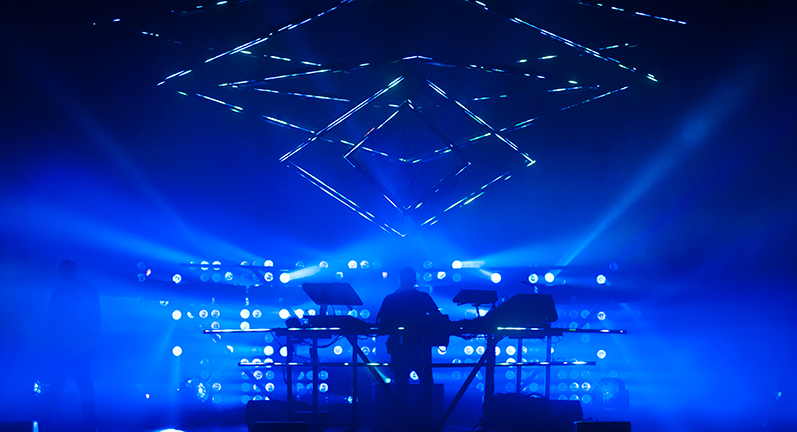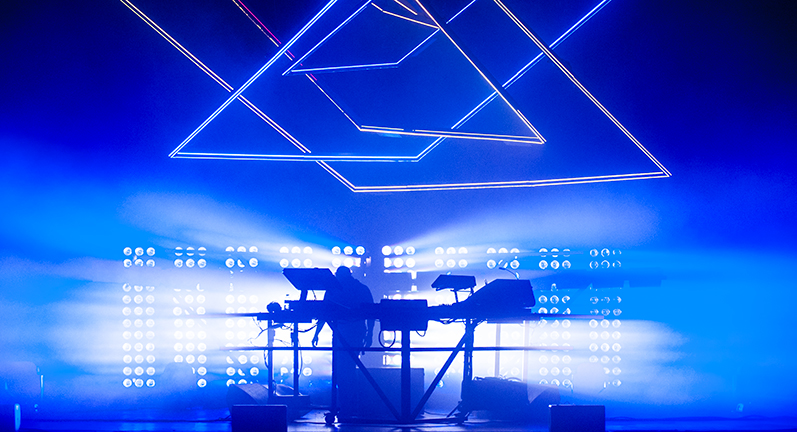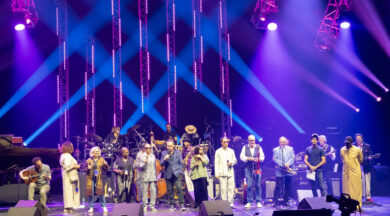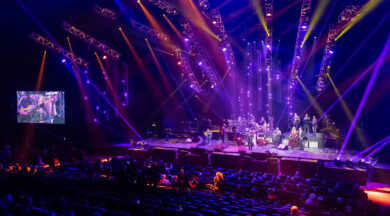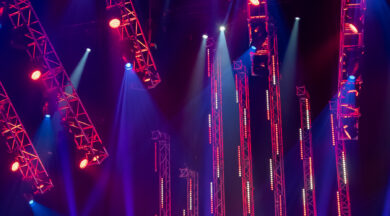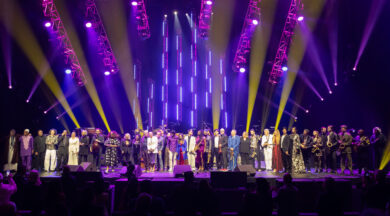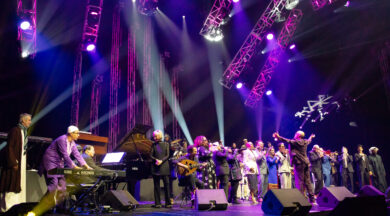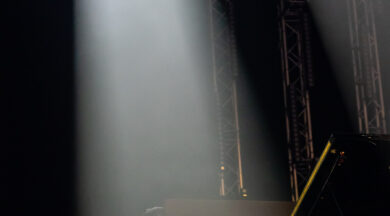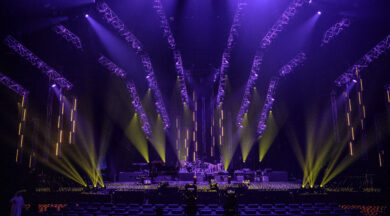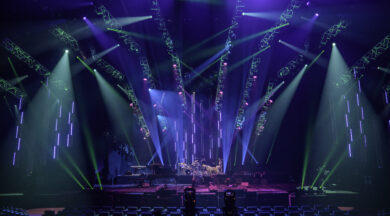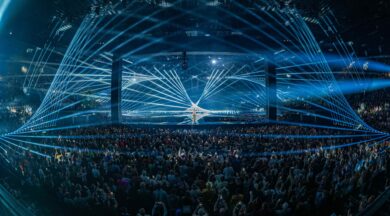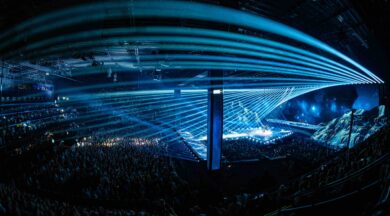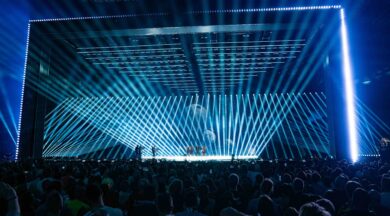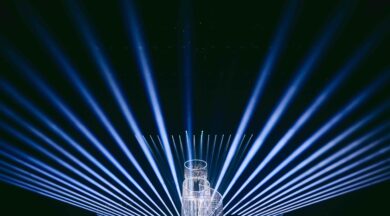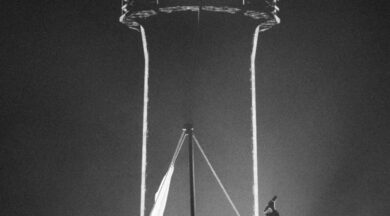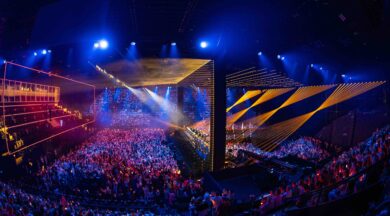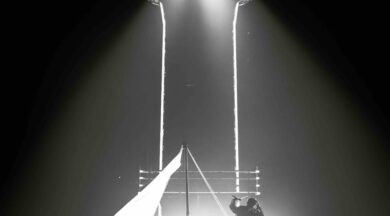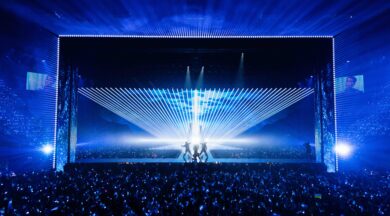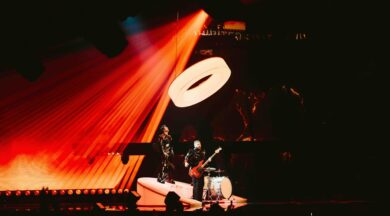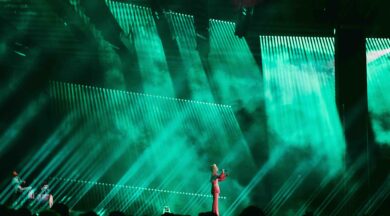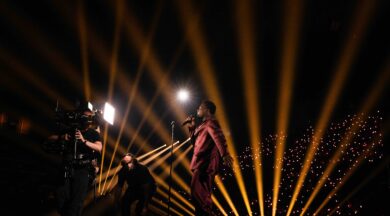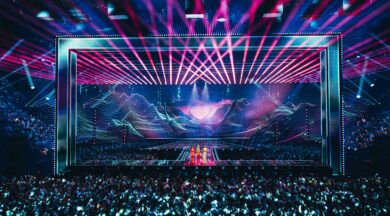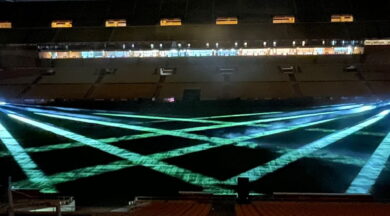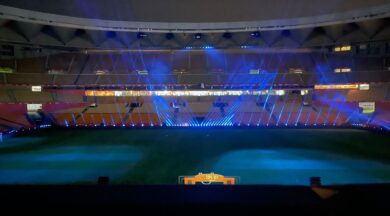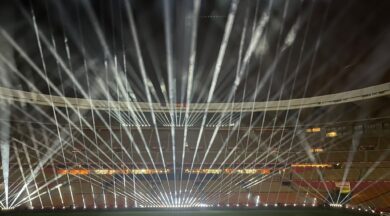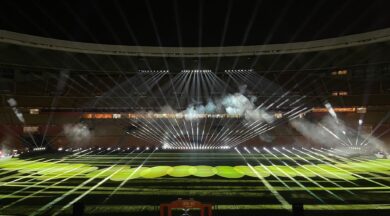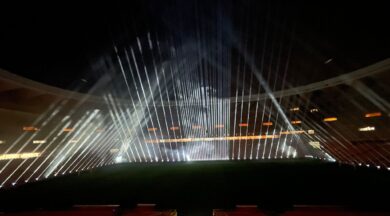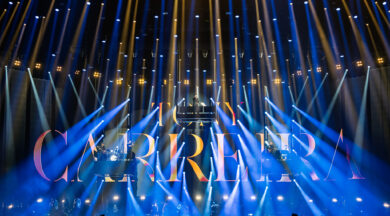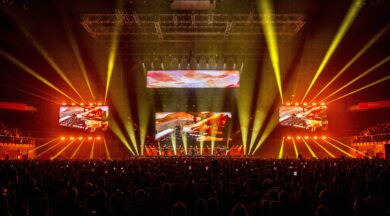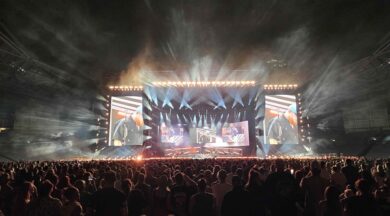Vitalic and Ayrton go on Tour with a spacecraft! At the Aeronef Lille Venue in France
French electro musician Vitalic is out on tour, and the All Access Design group have conjured an outstanding scenic design concept: a luminous, moving “space oddity” suspended over his head and an array of Ayrton MagicDot™XT and IntelliPix™XT fixtures embedded in a wall with a line of strobes and indispensible beam projectors behind. We saw the show at the Aéronef de Lille venue, and our immediate reaction was “WOW!”
The tour, which started in September 2016, was well under way when we discovered this extraordinary polymorphic flying machine – custom made by All Access Design. Measuring 5 meters x 5 meters, it consists of five concentric aluminium frames with LEDs embedded in the interior and on the exterior and lower edges, and the position of each frame controlled on 4 motors. It can take on a multitude of different geometric shapes, enhanced by video content fed to the LEDs – some 20,000 RGBW pixel are mapped.
We previously spoke with Jordan Magnée, one of the art directors for All Access, who could not make it to Lille for this concert. On the night of the show, Samuel, Victorien and Vincent met with us at the Aéronef. But first, we were able to interview Vitalic himself – or, Pascal Arbez-Nicolas, as the electro dance music sensation is known offstage, So cool!
An artist involved in the artistic process
SLU: How did the set design project start?
Vitalic: I didn’t have a specific idea, but we wanted to come up with a design that was relevant to the music and in keeping with the album theme. I gave some key words to the designers, and All Access Design came up with this great concept. It was the best idea proposed.
SLU: Weren’t you apprehensive about that object?
Vitalic: At first I was, because I didn’t know how, or if, it would work well on the tour. It’s a pretty heavy object, after all. But now, being underneath it during the concert doesn’t bother me a bit.
SLU: What’s your impression?
Vitalic: It feels like I’m the captain of a spaceship. That’s the idea, and I think it works.
SLU: Does it affect how you perform?
Vitalic: No, but I know how it’s pre-programmed, so I can anticipate a little. I get excited when I know certain sequences are coming up (laugh)!
SLU: Do you get feedback from the audience?
Vitalic: Yes, I feel it directly. Overall, the feedback is really, really good.
SLU: Does an electronic musician have to provide set design these days?
Vitalic: No, for a long time I toured without it. That works too, but I felt like taking my project to another level… pushing the limits. It’s really exciting. I’ve been involved with the designers on the light sequencing, and it’s great. We work together with a lot of flexibility and no ego issues. It’s a real pleasure.
SLU: Do you have specific requirements as to how the structure moves, the visuals being projected, and the colours?
Vitalic: I’ve often used ideas that are suggested to me, but I have the best vision on how to do my show, and for the sequencing, I’ve pretty much decided what I want. As far as colour goes, I told them what I need – a sort of colour code, like going to red at intense moments.
A retrofuturistic set design
Jordan Magnée: Three of us worked on the project together. I was in charge of set and media design – and art direction. Samuel handled the lighting design and the network with Victorien. So we all worked on the creative side.
We started with the artist’s need for a unique set design that has had a real impact on his concerts. For Vitalic, the set design plays an important part because he was one of the first electro musicians to integrate digital art into music.
He wanted to evolve this tour to a retro-futuristic scene – to explore an avant-guard concept that breaks with what has gone before.
Our concept was to create an object that would be suspended over him and that could interact with the music. We decided on this kinetic sculpture made up of 5 concentric square frames, with each connected to four motor points, so that the object is alive. For Vitalic we wanted something to happen, physically – so the suspended object could create a different design for each song.
The structure is lined with LEDs and it projects video content, so physical changes are accentuated by the video movement.
Then we built a big array at the back with Ayrton IntelliPix-XT fixtures to surround the structure by using beams to play on the depth of the stage. This wall is embedded with MagicDot-XT units to create beam movements, and then the entire rig, the array and the flying structure are completely pixel-mapped. We use the same media for everything, which creates a unified look.
There is a great variety of content: very graphic visuals, then more video-ish material, mixed pixel by pixel. We really played on the variations.
It’s a big toy and we have to keep it under control. It’s brought up a lot of issues.
The square structure points forward, toward the audience to emphasize the angles and depth of the stage. In opposition, the IntelliPix-XT matrix is angled upward at the rear to emphasize the oblique angles and depth.
We’re happy with the result, and it’s pretty innovative. For Vitalic, there’s major sync between music, the physical movements and the light and video cueing, which makes the music more intense.
Hanging and adjusting the equipment on a daily basis
When we got to the Aéronef in the early afternoon, the rig had already flown. The five frames were hung and connected. They moved and shimmered. Vincent lay underneath with an iPad in hand. Samuel and Victorien manned the lighting desk.
SLU: Vincent, what are you using the iPad for?
Vincent Leroy: I’m checking the movement of the motors, making sure that the frames don’t interfere with each other. I have a kill-switch in case they collide. When I finish my setup and safety tests, the grandMA will take over. It has the same control mode as the iPad with the TouchOSC interface.
Victorien Cayzeele: Every day there are some adjustments to be made due to the height of the different concert halls. Yesterday, in Brussels, the grid was 7 meters-high and today we’re at 6.2 metres. Control gets more complicated whenever we go over 3 meters. Every day we program in the height of the show so, as the tour progresses, we can dig into the memory for the height pre-sets.
SLU: Are the winches controlled from the console?
Vincent Leroy: Yes, through ArtNet™. We sent the XYZ (attitude, pitch and roll) coordinates to a winch-dedicated server, as if they were luminaires. The server, based on VVVV firmware, interprets that DMX into motor control. The server runs over three different networks. It picks up the ArtNet from the console on a network card, the DMX from the winches on another network card that’s physically separate. A third separate network carries the control signals. So there are three network cards in the machine.
SLU: What about overall safety?
Victorien Cayzeele: It’s the same as with any moving truss using a safety chain: whenever there’s movement overhead you need at least three safety points. We have an electrical safety point, a command safety point through the VVVV server, and a safety point at the console. There is also a data safety mechanism and a “dead man” switch which must be activated by Vincent every 30 seconds during the show or everything stops.
SLU: And the moving object works in all the clubs?
Samuel Chatain: We have two versions: one with five frames like this one – the full deal. Then, if we don’t have enough space we can remove some of the IntelliPix™ wall, which is segmented, and remove the two biggest frames – as we recently did at La Laiterie, the club in Strasbourg.
Victorien Cayzeele: The whole rig is not very heavy: 1.5 tons, but one of the points has to carry 600 kg, which means sometimes we have to adapt.
SLU: How many points in total?
Victorien Cayzeele: Four. We looked at all possible solutions ahead of time, given the constraints of the venues, so that we could have the maximum amount of manoeuvrability.
Equipped with RGBW LEDs
SLU: Let’s talk about the LEDs that light the frames
Victorien Cayzeele: It’s an RGBW strip controlled point-to-point with a small 6.7 mm pitch. I’m running 219 universes just for the LED strips on the frames, Vitalic’s lighting desk and the DJ Booth. We have them on the inside and outside of the frames and underneath.
We’ve never done a project before with so many LED strips.
When Samuel and I started the blueprint of the frame integrating the LEDs, we had to define very specific lengths for all the rods. We made up some spares. If one of the rods breaks, we replace it. The aluminium casing has the dual advantage of protecting and cooling the LEDs. After laying it all out, it took 4 people for 4 days to attach the LEDs at CMDS and we stayed for 7 days with Sam to wire everything, drill the sheet metal, set up the mounting plates… It’s all custom and handcrafted.
SLU: How is IntelliPix™XT used on the project?
Victorien Cayzeele: We wanted to have an array while using the MagicDot-XT. The advantage of the IntelliPix-XT is that it has the same collimator and emitter as the Dot-XT, so all the LEDs are in perfect sync. We were really attracted to this product because the beam is really very, very tight and has a lot of output. Léon Van Empel from S Group, who provides the lighting gear, went along with us. He’s been very proactive.
Samuel Chatain: We had worked with the MagicDot™R on previous tours. This time we wanted the MagicDot™XT to have a little more power. Ultimately, we installed a fixed array of IntelliPix-XT units integrated with MagicDot-XT fixtures that project exactly the same quality of light – so the wall starts to move.
Victorien Cayzeele: Today, our IntelliPix wall is flat because we don’t have enough stage depth to form a V, with the point forward, but the concept is to open up the array and work the volumetrics to bring out the angles… and open up the sense of perspective in the show.
SLU: Is the wall easy to set up?
Victorien Cayzeele:Yes, we had fixture frames made up by CMDS Factory, with dedicated mounting points for each unit, so it’s quick.
Samuel Chatain: IntelliPix™XT creates a real cool array that can also let you do fantastic ceilings with big light shafts.
SLU: The sound, light and video has to be synced…
Samuel Chatain: Yes, the artist is used to having a full sync, and even if we are not crazy about this kind of playback, the show uses sync for about 80%. But we’ve created a system that also allows us to adapt and respond live.
With all the experience that our company has on different sites, between LED integration, media servers and motion control, this is the first project where we’ve been able to integrate all our know-how, and bring it to a much higher level. Previous experience has served us well!
Start your engines!
The house is packed with 1,500 people standing on the ground level, plus 500 more on the mezzanine. It was starting to get a little warm… but then magic began! As you’d expect the sound grew louder, with the music surrounding and absorbing us. The artist stands out against powerful and saturated red backlight. The frames, brought into upright position, described the iconic “V” of the artist, taking up almost the entire height of the stage. The effects came almost too fast for my camera to capture any still images. Each change of scene causes the audience to react – from shouts of awe to groans of pleasure. The motorised frames and the point-to-point control of the LEDs display an infinite number of angles, structured as a pyramid, then biased, in a massive, threatening platform above the DJ, de-structured, chaotic, shimmering. Even their thickness appears to change through the three ribbons of LEDs surrounding each metal frame.
The back wall of IntelliPix™XT fixtures appears as a source radiating from outer space, and when the light shafts from the MagicDot™XT units join in, it all comes to life: awe-inspiring. A fantastic effect! Vitalic’s music is rich, and each element fully plays its role. We can clearly see why Samuel and Victorien were in preproduction for two and a half weeks at S Group to program the show!
Vitalic’s show is electro music at its best. On his previous tour, he used an unusual array of Sharpys. Challenged with coming up with an even more mind-bending project, All Access Design raised the stakes by realizing an outrageous set and lighting design concept – at some considerable risk – but the artist went for it and embraced the project.
Wow, what incredible work. Bravo!
Photos: © Monique Cussigh – © Toma Pilato
